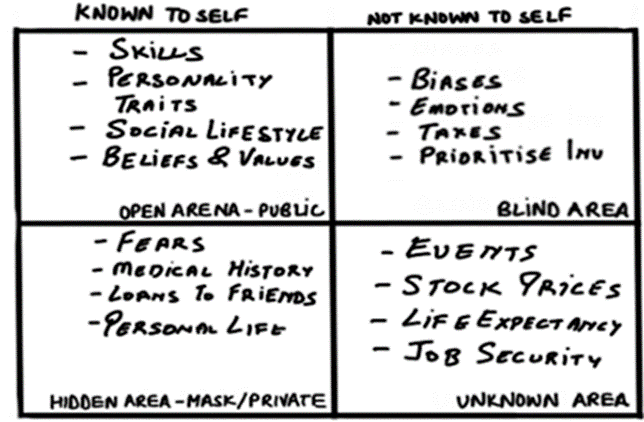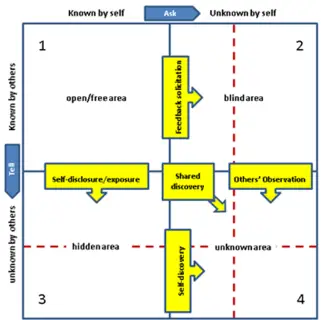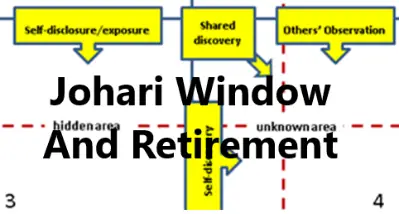Retirement and the Johari Window
The Johari Window is a novel through which to view retirement. In a simple 2×2 grid, you can better understand the challenges you’d like to take on in this phase of life.
In management, the goal of Johari Window is to better understand yourself and your relationship with your team.
In retirement, the Johari Window creates self-awareness and encourages the discovery of retirement happiness. The “unknown” might just please and excite you in retirement.
What is the Johari Window?
The Johari window is a 2×2 grid that has four quadrants. Each quadrant reflects what is known (and not known) to you and others.

As an example above, we have the four quadrants with self on the top and others (or “team”) along the side. Thus, the upper left quadrant is known to self and others (the public you), and the bottom right quadrant is the unkown (both to you and others).
Top Right is the “blind spot” where others know more than you, and the bottom left is the facade you present to the world.
Let’s learn more about each quadrant and see how the Johari Window ties into retirement happiness.
The Public Me
The upper left quadrant is the “you” that is public and known to others. Not only do you know this is “who I am,” but you advertise it. “Hey, world, I’m retired, and these are the things that I care about.” Herein lie public activities that you talk about openly with those you encounter.
In management, the idea is to shift the other quadrants (where there is a lack of clarity or certainty) into this public quadrant where all is visible, safe, and known. In retirement, these are the activities you participate in socially; fun and stable and all, but not the area for growth and potential novel happiness.
The Blind Spot
Next, the upper right quadrant is your blind spot. These things are hidden from you, but other people see them clearly. If people were to talk behind your back (which, frankly, doesn’t happen nearly as often as we think), this is what they recognize in you that you fail to see.
In management, one could consider this the area where you (as a leader) are self-ignorant. While not a productive team space, the Johari process aims to reduce this area through active feedback and increased self-awareness.
The blind spot is where your biases lie and might be improved through the study of behavioral finance. But, unfortunately, the blind spot is also where Dunning -Kruger lives (we overestimate our competence in areas where we lack information).
Fortunately, though, it is also where an attitude of humility meets a willingness to grow.
The Facade
The lower left quadrant is your Façade, what you hide from others. Sometimes called your mask, these are the “personal” things you hide from others.
Also called the ‘hidden self’ or ‘avoided area,’ you place feelings that seem socially unacceptable.
In management, hidden items become known through a selective process of ‘self-disclosure’ (which, of course, depends on company culture).
In retirement, your façade includes dreams or fantasies too sensitive to share with others. What a rich area to explore!
Unknown Unknowns
Finally, the lower right quadrant is the “unknown unknowns.” Also known as untapped potential, this is where risk management comes into play in retirement. In addition, here, we have the greatest ability to divine what is true for ourselves or the world. Through trial and error, here you might discover happiness in retirement.
The unknown unknowns contain feelings, latent abilities or aptitudes, and possible experiences that are unexplored. This is a rich area to exploit, as you re-visit childhood dreams and perhaps add layers of complexity to your life that you have previously not considered. Retirement happiness is in the unknown.
How to Use the Johari Window in Retirement
So, if you run a team, you list the personal properties that you believe reflect yourself, and your team does the same. So of the, say, 40 properties, you list ten, and your team lists 10.
Properties found in both lists go in “the public me.” Those others list that you don’t are the blind spot, and those you write down that others don’t are your facade.
Finally, those properties that neither you nor others think you possess go in the unknown quadrant.
In retirement, a similar list (commonly known as a “bucket list”) of activities or experiences substitute for personal properties.
Imagine knowing what you know, what you think that just ain’t so, and what you don’t yet know. Now, can you find retirement happiness in the unknown unknowns?
Your Bucket List and Johari Retirement
Find a bucket list here. (Below is one example of many from this site)

Next, mark your top ten items, and have a few friends who know you do the same (they would indicate which experiences or skills they think you enjoy).
Then, fill out your retirement Johari quadrants.
You now have a list of unknowns to explore and, perhaps as importantly, some knowledge of blind spots and facades.
Now, use this information to find the answer to retirement happiness!
Using the Johari Window to Find Retirement Happiness
Below is a schematic of how to use the Johari window to find retirement happiness.

To have a better quality of life, we want to move beyond the public you. Through feedback, self-disclosure, self-discovery, and shared discovery, you shrink the non-public quadrants and find more of what brings juice to your life.
To thrive, consider allowing others to see your weaknesses. After all, topics like Shame and Physician Burnout are only addressed through open and honest dialogue. Self-disclosure and shared discovery lead to a more healthy you.
Further, I believe that we find real retirement mellifluousness in the unknown. Joy and flow are found neither in your façade nor your biases. The answers to a happy retirement are in exploring the unknown.
Summary — The answer to a happy retirement is in the “unknown”
The Johari window is a tool to improve your management of a team.
Now, find retirement happiness in the unknown Johari window quadrant. Reduce the unknown area through trial and error: use others’ observation, self-discovery, and mutual enlightenment to discover happy coincidences.
When you do less of what is expected, you improve your blind spots, desiccate your façade, and potentiate new outlets for your passion and talents.
